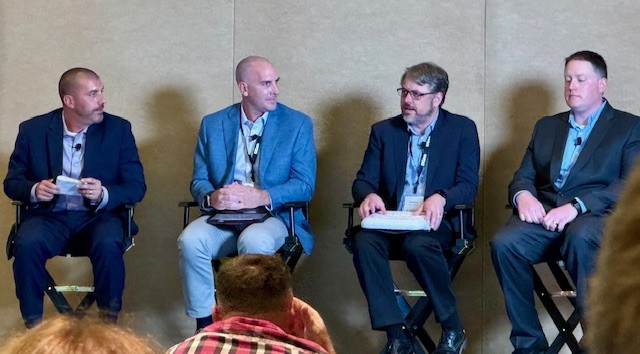
The Dangerous Goods Symposium once again proved to be the go-to place for the DG industry to come together to exchange insights and collaborate. This year’s symposium gave attendees the chance to learn directly from government regulators and top professionals across the DG, logistics and supply chain sectors.
Here’s a quick snapshot of the event:
- 15+ presentations/panels with industry leaders
- 36 speakers
- 250+ attendees
From sustainable packaging innovations to digitalization, regulatory changes and workforce development, this year’s Symposium examined the critical trends that are reshaping the way dangerous goods are transported and managed.
Below are some highlights of the event and the exciting momentum driving the industry forward.
How Innovation is Driving the DG Industry Forward
Robert Finn, Vice President of Marketing & Product Management at Labelmaster, kicked things off with the results of this year’s Global Dangerous Goods (DG) Confidence Outlook. Conducted by Labelmaster, IATA and HCB, the survey gathered more than 1,000 DG pros around the globe to understand innovation within the DG supply chain and barriers that exist.
Two major areas of innovation stood out: digitalization and sustainability.
According to the survey:
- 83% of DG pros report efforts to digitalize their DG operations
- 81% said their companies have sustainability practices in place
Of course, challenges remain in the way of progress. One of the biggest issues? Misdeclared or undeclared goods, cited by 80% of DG pros as a significant problem.
However, despite the hurdles DG professionals are facing in today’s industry landscape, there is a strong sense of optimism within the industry. Finn noted, “Even with these challenges, there’s never been a more promising or positive time to be in this industry. The innovation has been amazing and DG pros are evolving to meet the demands of the future.”
With so much progress being made, it’s clear the DG industry is on the right path—and the future looks bright.
Introducing DGeo
Robert Finn noted that the push for innovation within the DG industry motivated Labelmaster to expand its capabilities to help customers meet this unique transformative moment in the industry. This led to the creation of DGeo – The Packaging Division at Labelmaster.
According to Finn, “DGeo thinks about DG differently by leveraging creativity and multi-industry expertise to transform your packaging operations and improve overall sustainability.”
He added “Couldn’t your box do more? What if your packaging solution could improve process optimization? What if it could be the cornerstone of your company’s sustainability initiatives? What if it could reduce warehousing and logistics costs? DGeo is a group of DG pros who want to do things differently because we know there’s a better way.”
He highlighted how DGeo’s product and solutions integrate beautifully with Labelmaster’s existing solutions, such as DGIS technology, reporting and DG expertise, and brings in logistics and warehousing operations and expertise to do an end-to-end solution for DG packaging.
A DG Master Class from Industry Veterans

A panel of DG industry veterans and inductees into this year’s DG Hall of Fame took a deep dive into what the future of the industry holds when it comes to regulations, data and talent. One of the main takeaways? There is a need for simpler, more practical regulations to encourage compliance and make the supply chain safer.
Kristel Vermeersch from KVS & Partners BV emphasized, “The way these regulations have been written is not always clear. I strongly believe that we need to take a pragmatic view instead of adding on to the regulations…If we want to make our transport safer, we are not going to reach that by making regulations more complex.”
Geoff Leach from The Dangerous Goods Office, Ltd. agreed. “We must figure out how to make it easier to implement what the regulations are. We need to take a very pragmatic approach to how to ship dangerous goods…The danger is if they’re not easy to comply with or get rejected for silly reasons undeclared goes up…We want people to comply and so we have to make it easy for people to comply.”
Data is the DG Industry’s “Holy Grail”
The panel also discussed how crucial data is to the future of the DG industry – but noted that getting it can be a major challenge.
Former ICAO DG Panel Secretary, Katherine Rooney, called reliable data the industry’s “holy grail.” But she said that it’s elusive, largely due to uncertainty about how many undeclared dangerous goods are being shipped.
Geoff Leach added: “If we could just somehow get a handle on how big a problem is…Nobody can answer ‘How many undeclared dangerous goods are transported?’ because, thankfully, most undeclared goods have made it to their destination – and nothing happened.”
The panel stressed the need for investment in digital technologies that support a safer, more compliant global supply chain. However, for some, this may require a mindset shift for some companies when it comes to dangerous goods.
The Role of Packaging in Sustainability

Sustainability has become a hot topic across all industries and DG is no exception.
A panel of packaging experts dove into the evolution of sustainable DG packaging and the challenges that have slowed its development and adoption.
The key challenges (and solutions) they discussed included:
Challenge 1: Low recycling rates
Scott Dyvig from Lifoam Industries pointed out that while the infrastructure to collect materials like EPS exists, there’s not much active effort in collection. Instead, the industry is turning its attention to creating materials with better end-of-life solutions.
Challenge 2: Misperception of lower performance of sustainable packaging options
There’s a misperception that sustainable packaging just doesn’t hold up as well as traditional materials. But Scott Connolly from CurTec USA shared that in their tests, sustainable options – like recycled and bio-based materials – performed just as well, even in tough sectors like pharma and chemical packaging.
Challenge 3: Misperception that sustainable packaging is more costly
Nick Downey from DGeo tackled the common belief that sustainable packaging is more expensive.
However, he encouraged attendees to think beyond the initial cost of packaging. Why? Because sustainable solutions can sometimes lower transportation expenses, save warehouse space, and even help attract and retain customers and employees who value eco-friendly practices.
Innovative solutions like Capsuloc and the Obexion family of products for shipping lithium batteries are addressing these concerns. With these innovations, DG packaging is becoming more sustainable and efficient without sacrificing performance or safety.
DGeo’s John Glaser said, “There’s always been a little bit of fear when it comes to sustainable packaging in DG because it must be regulated. Is it tested? Is it certified? But we’re seeing an advancement in materials today and material test standards are now giving us notable support.”
The conversation made one thing clear: Sustainable packaging is on the rise in DG, and the benefits are becoming hard to ignore.
Lithium Battery Panel

Lithium batteries are everywhere but shipping them can be tricky – especially with constantly evolving regulations.
That’s why the Lithium Battery Panel is always an DG Symposium attendee favorite, offering DG professionals a chance to stay up to date on the latest transport rules, packaging standards, and safety measures for large and small batteries alike.
During this year’s panel, Tim Rogers, Head of Dangerous Goods for UPS Airlines, pointed out a concerning trend: incidents involving lithium batteries are on the rise. This includes undeclared and accepted/compliant packages for both stand-alone batteries and batteries within equipment. He cited poor quality outer packaging, poor or inadequate inner packaging and the state of charge being over the limit as key causes.
According to Ben Firkins, Head Cargo Safety and Dangerous Goods for OSS-CARGO-Safety and Standards, “People don’t naturally try to not comply with regulations.”
He noted some difficulty in shipping lithium batteries safely is likely due to the unclear (and downright confusing) language in DGRs intended to assist shippers.
Common problems include:
- The legal style writing of the DGRs
- Direction containing double and triple negatives
- Contradictory variations of language
- Variations that prohibit what is already not permitted
- Variations delivering the same outcome through opposite wording
Firkins stressed the need to clear regulations that make it easier for shippers to understand the comply.
DGeo’s Mike Cicalo rounded out the discussion by sharing some common mistakes shippers make when it comes to shipping EV batteries.
- Believing DOT regulations don’t apply to their batteries
- Believing they can ship their batteries without special training
- Thinking they just need a crate
- Underestimating the time to design, build and test packaging
- Ineffective (or no) plans to assess the condition of reusable packaging
- No process for identifying non-damaged or end-of-life batteries
- Misalignment with supply chain partners
Pulling from his 23+ years of experience at GM helping automotive manufacturers and suppliers transport batteries safely and efficiently, Cicalo stressed the importance of having a strong program for managing EV battery transport, which includes having right partners.
He added that businesses (and their customers) don’t always know how to properly package and ship EV batteries. Often, it’s because they’re working without documented process to help employees and supply chain partners understand the requirements. It’s why working with a DG partner who knows the regs backwards and forwards is so vital.
Another Year in the Books
DG pros may not wear a cape, but there’s no doubt they help keep the worlds safe as hazardous goods are shipped around the globe daily. We’re grateful for the opportunity to bring these everyday heroes together to hear from the world’s leading trainers, shippers and regulators.


